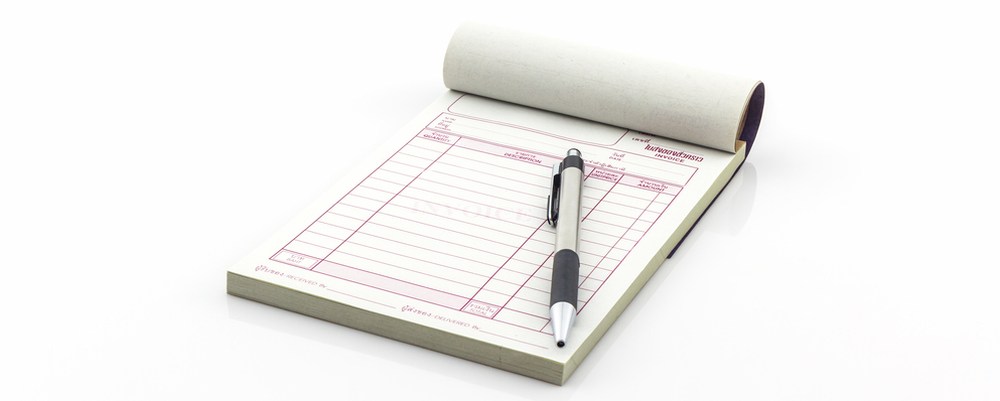If you have a business, you know what an invoice is. You are probably also aware that Billdu helps you create invoices on the go. But, have you heard of a Proforma invoice? If not, you could be wondering what is a Proforma invoice? We want you to understand exactly what this vital piece of your business is, we’re going to outline it for you. We’ll also walk you through a step by step tutorial on how to create a pro forma document using Billdu’s printable proforma invoice templates.
Understanding a Pro Forma Invoice
As a seller or business owner, getting clients, negotiating the working relationships terms, and deciding on a price all common business practice. However, you want to ensure that everyone is on the same page once you work out all of the finer details that come with negotiating a new contract. This is where a pro forma invoice comes. Basically, it acts as a precursor to your official invoice.
This document will let your clients know exactly what services or products you’re going to deliver, your timeline for delivering said goods or services, and how much the project will end up costing your customers. It’s a short heads up before you send the normal invoice for payment, and it can help your customers from being blindsided by the price or duration of the project.
It helps everyone get on the same page for expectations, and it also gives your customers time to organize their finances so they can pay your invoice when it comes through. It’s essential that you know that your pro forma invoice isn’t a true VAT invoice though. However, it can help your project go along more smoothly because everyone will have the same expectations.
There are dozens of reasons why you’d want to use this type of invoice for your business, and they include but are not limited to:
- Declare the value for your services or goods
- Inform your customers of the payment terms and the due date
- Let your customer know which payment methods your business accepts
- Notify your customers of the delivery details and dates
- Outline the goods or services your business will provide
- Send your customers a statement of how much your services or products will cost
It works to square away the many small details that can hinder a project or a payment, and it ensures that everyone is ready for the project to start or to receive the goods they need. Once you officially start the project or deliver the goods, you can send out an official invoice.
Items to Include in Your Proforma Invoice
Before we walk you through how to create a proforma invoice, it’s important that you know everything that you should include. This way, you can be sure that you populate the correct fields each time you use a pro forma invoice template at your business.
Header
The first section you’ll work on filling in is your header. It’s extremely important that you have the words “Proforma Invoice” clearly displayed here. Your header should also contain your business’s logo and name. It makes it easy for your customers to locate it if they misplace it. You typically print it on your business’s letterhead, so you’ll typically have this information.
Invoicing is a way to demonstrate your professionalism. We can help you to cover the whole range of what to include on an invoice.
The next section on your header is where you fill in your company’s contact information. You’ll list your mailing address, telephone number, website, email address, and the country of origin. The date you created the invoice, the date your customers requested it, and the date the invoice expires is also helpful.
Customer Contact Information
In order to help keep all of your invoices separate and easy to find, it should include your customer’s name or business name along with their contact information. List their mail address, company name, phone number, and company email address very clearly on your invoice.
Invoice Dates and Number
Each invoice you send out should have a unique number because you’ll reference it in your business’s accounting information, and the customer will also use it in their accounting system. While you can start anywhere you’d like and use any numbers you like, they should be sequential. This means that if this invoice’s number is “Invoice #00112,” the next invoice you send out should be “Invoice #00113” to keep things organized.
You’ll take these unique numbers and use them in a tracking system. When you pull the unique number, you should instantly be able to tell which customer you sent the invoice to, the date you sent the invoice, and when the customer’s due date is.
Reason for Exporting Your Goods
If your business exports goods, you have to explain on the invoice why you’re exporting them in the first place. You should note whether or not the items in question are a sample, a sale, a return, a repair, or a gift. If it’s a temporary export due to repairs and it’s going to come back to you, you can put that it’s a “temporary export.”
Shipping Information
How do you plan to ship your goods to your customer? How many packages are there, and what do they all weigh? You should have this clearly listed on your invoice.
Itemized Charge List
Arguably one of the most important features on your proforma invoice sample is your itemized list of charges. This is where you have to be as specific as you possibly can because not being clear enough on this section is a huge reason many customers reject the invoice. The more specific and detailed you are, the less likely it is that a buyer will go with someone else. At the very least, you should include:
- Each good or service has its own line
- A detailed description that outlines what you’re selling or providing
- Number of units you plan to include
- Price point per unit of every individual item on your list
- Total cost
Shipping, Tax, and Total
You want to double check any tax laws to help you calculate the correct sales tax for your shipment. You also want to add any necessary shipping and handling charges. If you’re exporting to another country, this includes any duties that customs levies. This should be clearly shown on a single line. Add it together and put it on your total line. If you don’t, you could be liable for hundreds of excess dollars in customs fees, shipping, or taxes.
Footer
The final part of your invoice is the footer. This is at the very bottom of your invoice, and it’s where you can include any miscellaneous information. You can use it to outline your return policy or your guarantee. Also, it’s a good idea to put a short thank you in here for your customer because a little courtesy on your part can go a long way.
Ways to Create Your Proforma Invoice
You can use Google invoice maker to pull free pro forma invoice templates. They usually come with areas that you can quickly and easily edit and fill in to create customized invoices to send to your clients.
Many companies offer printable invoice templates that you can download, print off, and fill in the relevant information. This is more time-consuming to do, and you either have to mail it out to your customer or scan it into your computer before you send them an email.
Creating a Pro Forma Invoice with Billdu
At Billdu, we make it quick and easy to create an invoice online and track your invoices. We have filters in place on your dashboard that allow you to see all of your paid, unpaid, and overdue pro forma documents. We’re going to give you a step by step tutorial on how to create your invoice sample below to show you how user-friendly our platform is.
Later on try our trial how to create invoices online.
Step One – Create an Account
The first thing you have to do is go to Billdu.com and click the “Login” button on the upper right corner. This will open a new tab where you can click “create account.”
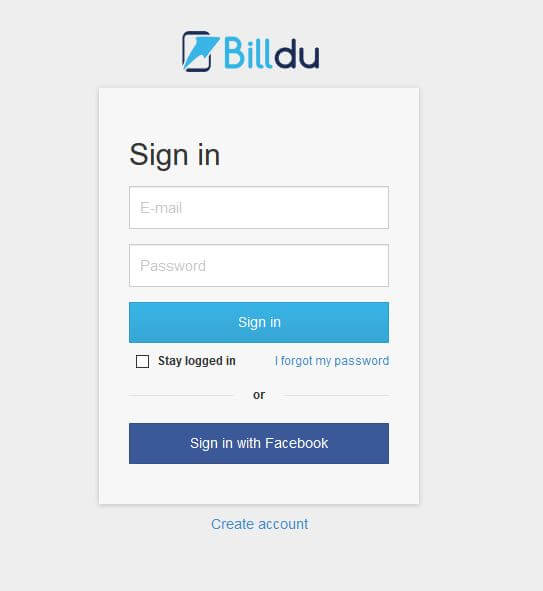
When you hit create account, you’ll enter your business name, email, and password before clicking “Create account” to finalize it. It’ll log you in and show you your dashboard. Now you can move to step two.
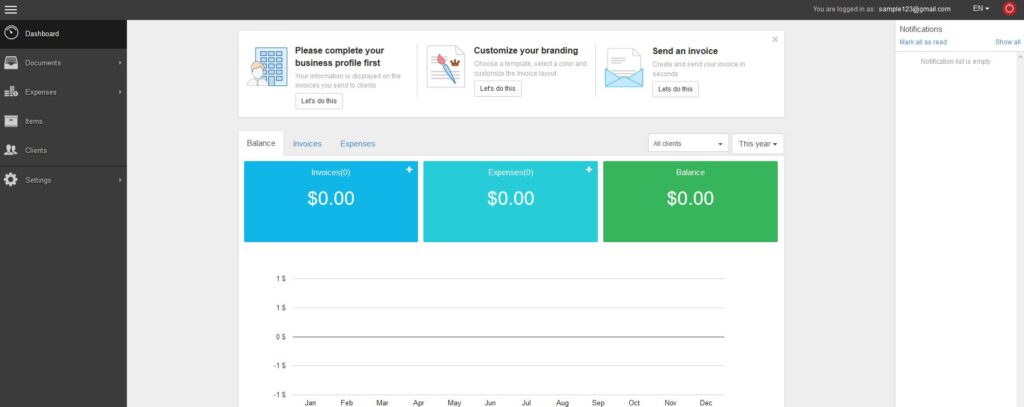
Step Two – Complete Your Business Profile
Before you can create any invoices, Billdu will prompt you to create your business profile, and you can open it by clicking the “Let’s Do This” button below the “Please complete your business profile first” box. Once you click it, a screen will open and ask you to fill in: your business name, country, street, zip code, city, and your province/state. The second section is where you choose whether you not you want to have taxes or no taxes on your invoices, along with your business’s tax registration number.
You should also fill in your contact information with your name, email, phone number, fax number, and website. You can upload your signature and your business logo as well.
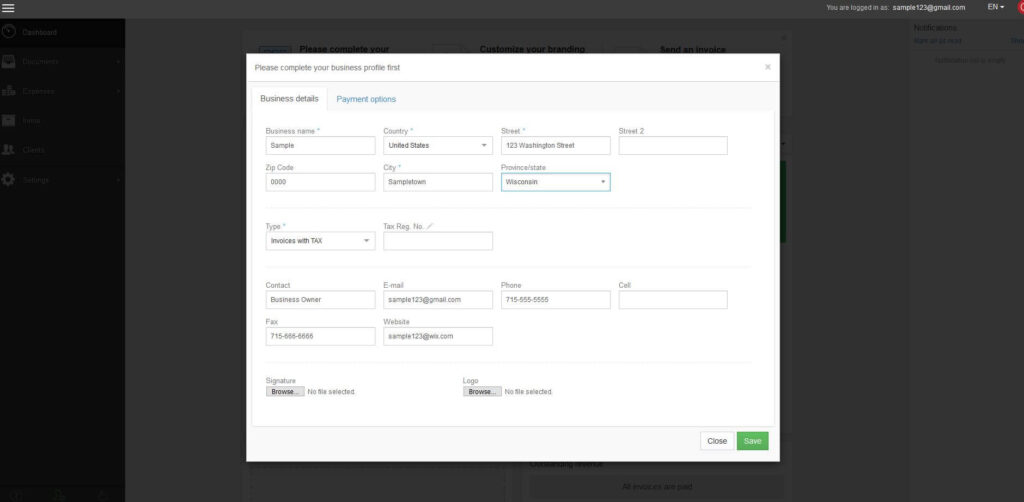
Step Three – Complete Your Payment Profile
Once you fill in your business profile, there’s a second tab you can open that allows you to fill in your payment information. You’ll fill in your account holder’s name, bank name, routing number, account number, whether or not you want to set up online payments and link directly to your bank account, and a PayPal email address if it’s relevant. Once you finish, click save.
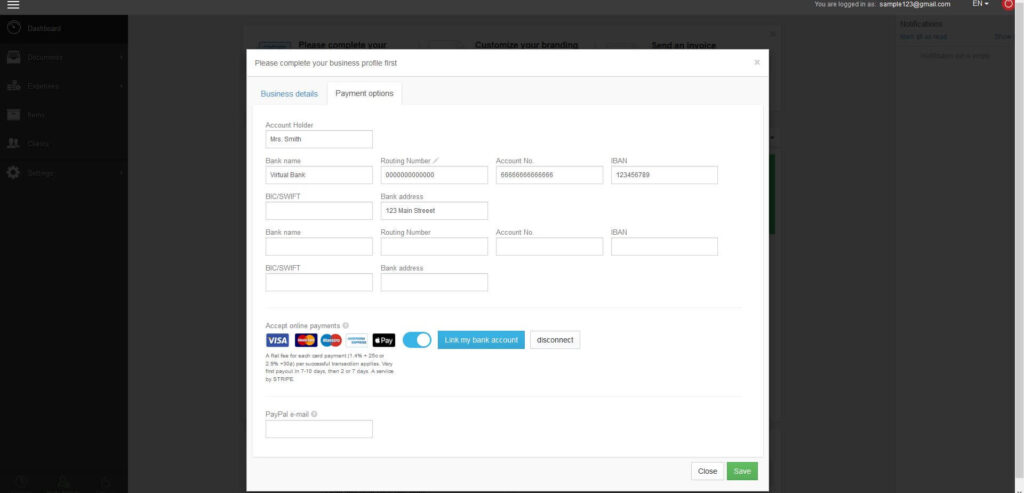
Step Four – Set Up Your Proforma Invoice
At this point, you can either stay on your dashboard and customize your branding with your chosen free invoice sample, color choices, and layout, or you can make your proforma invoice. For this tutorial, we’re going to go straight to the invoice. To get there, select the “Documents” tab on the upper left side of the screen. A drop-down menu will open, and you can pick the correct invoice format. In this case, it would be the pro forma invoice. When you click it, a template will show up.
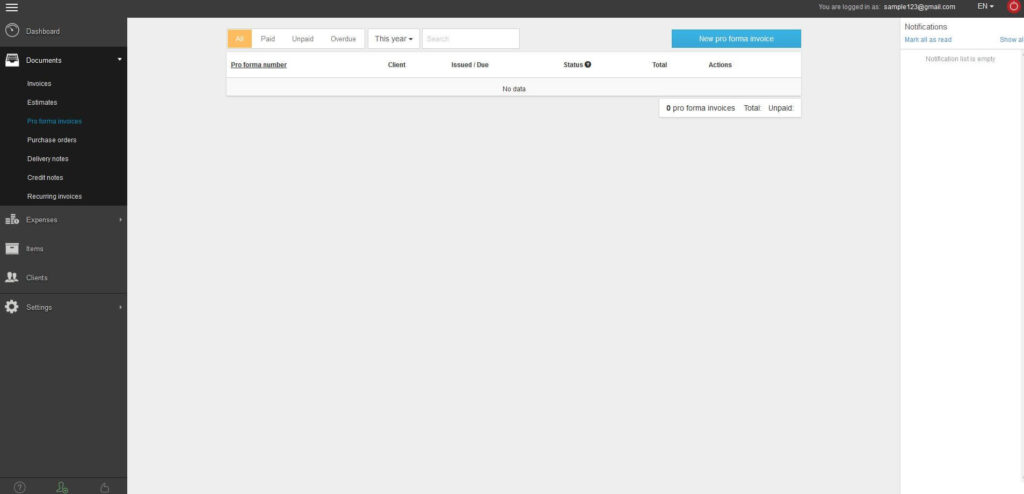
Step Five – Fill in Your Invoice
You start by clicking the blue “New pro forma invoice” button on the upper middle portion of your screen. When you click it, you’ll see:
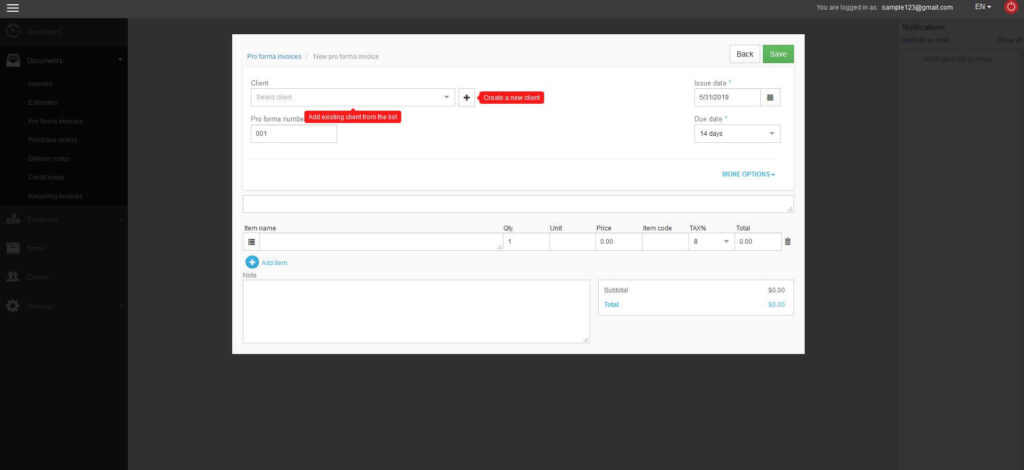
If you don’t have any client lists loaded in, you’ll click the + button to create a new client listing. A small box will open when you do this, and you’ll have to fill in the billing name, country, street, zip code, city, state/province, tax reg number (optional), email, contact, phone number, website, and fax number (optional). When you fill this in, click save.
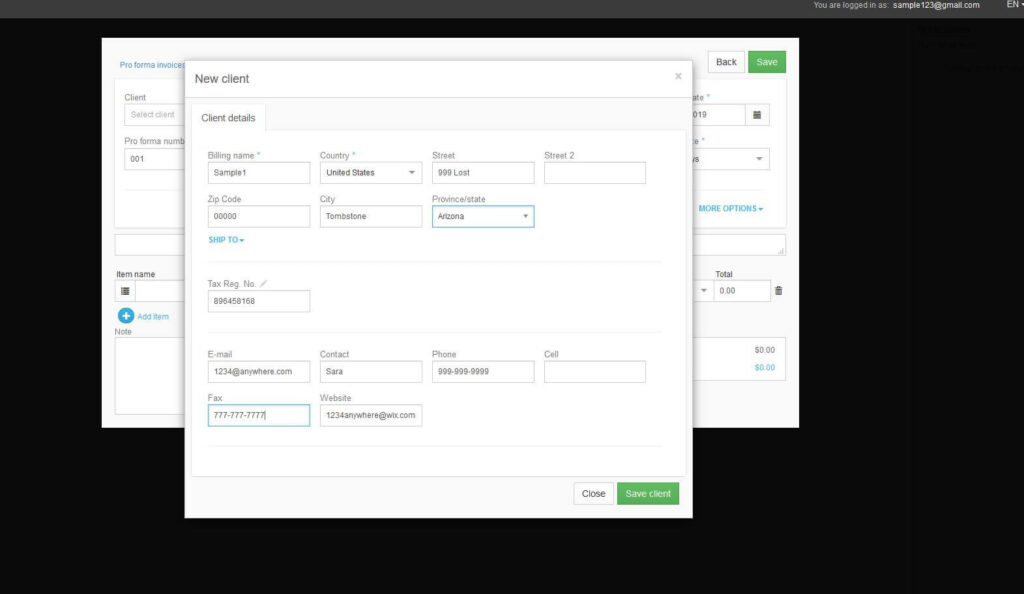
You’ll continue to fill in your invoice once you populate the client information. It’ll populate a pro forma number of 001, but you can change this. You’ll add the invoice issue date, due date, and a reference.
There’s a “More Items” option you can click that reveals a few more boxes you can populate. This includes the payment method, and you choose the way your customer is paying from the drop-down menu, which currency they want to use, and the language. The next portion to fill in is your item, the quantity, price, and any taxes. Once you get everything in, you can hit the save button.
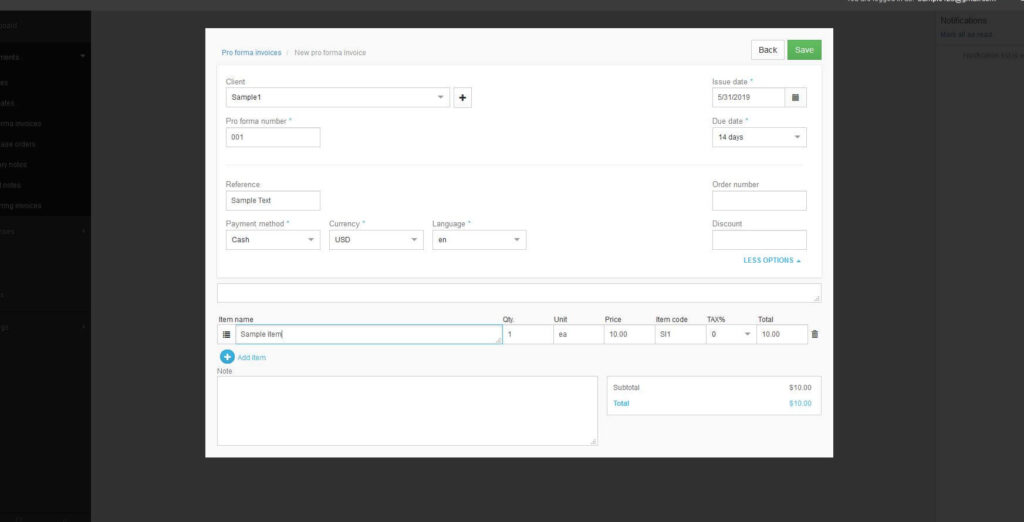
Step Six – Double Check Your Invoice and Send It
Once you hit the save button, your invoice will open on your dashboard. This is where you double check that everything is correct and good to go. You’re now ready to download your pro forma invoice as a PDF file, email it out, or keep it and add payments as they come in.
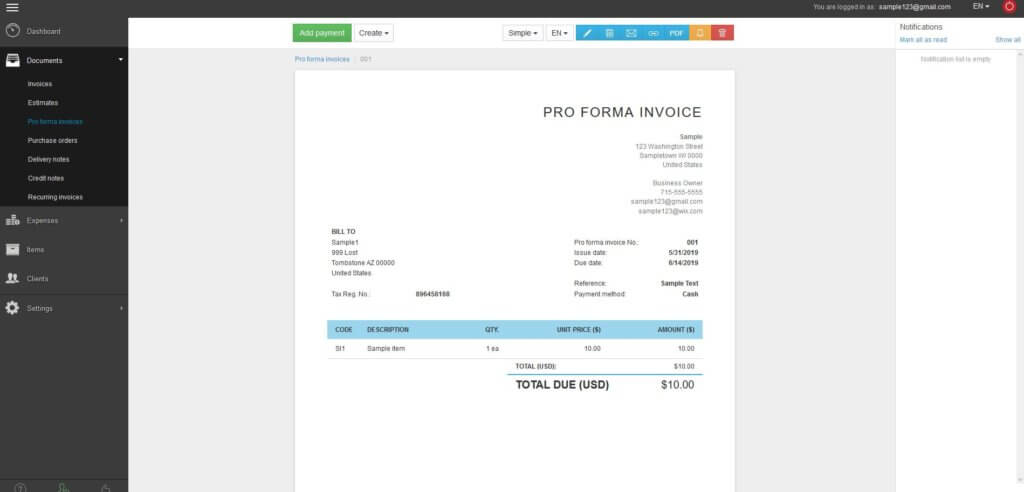
Your dashboard will automatically help you keep track of all of your pro forma invoices, and it’s easy to tell at a glance whether or not they’re overdue, paid, or unpaid.

